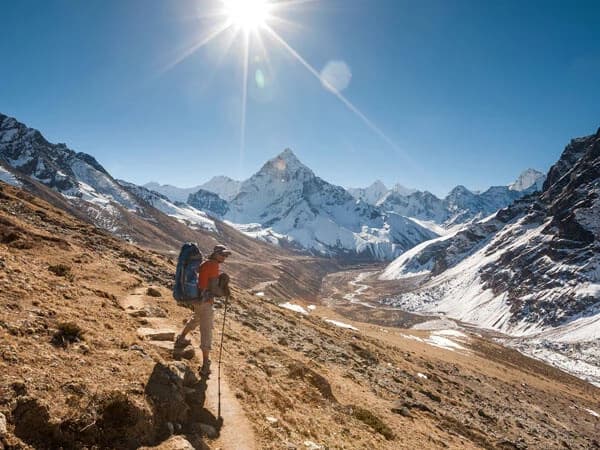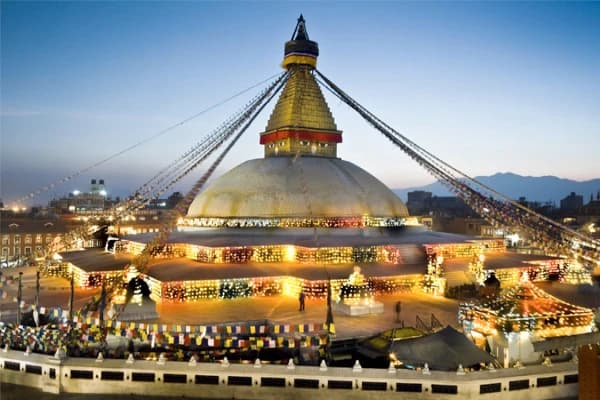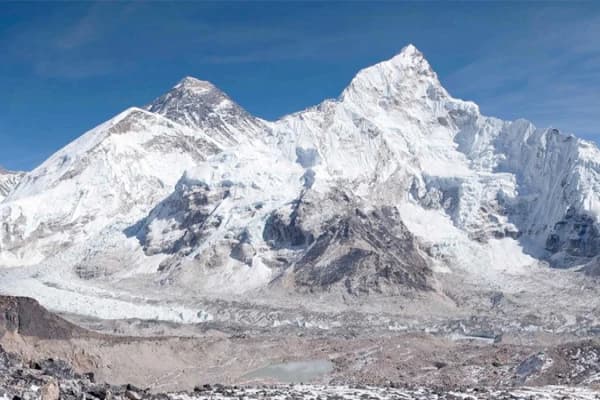Common Reasons Trekkers Get Sick on the Everest Base Camp Route
One of most common reasons why trekkers get sick on Everest Base Camp is due to sudden altitude gain, extreme weather conditions and constant physical movement. One of major Everest Base Camp trek health risks on trail is altitude sickness. Oxygen level can drastically drop as you move higher and your body requires time to adjust. This may lead to symptoms like headache, nausea, dizziness or fatigue. In severe cases, this can eventually turn into serious health conditions like HAPE or HACE if not treated early.
Walking for long hours on this trail can slowly fatigue your body and leave you feeling drained. If you take wrong path your energy level will eventually lead to exhaustion. Without proper rest or food your body lacks strength to manage at higher altitude trekking. Dehydration is another common problem. Cold weather alongside dry air can cause dehydration even when you do not feel thirsty. If ignored dehydration can worsen altitude symptoms and cause dizziness or confusion.
Poor hygiene can worsen your stomach issues if meals are undercooked or drinks get contaminated with impure water. This may even lead to food poisoning. Then exposure to cold temperatures can add another layer of risk by weakening your body even more. Windy conditions and freezing temperatures can cause hypothermia or breathing problems if you don’t wear proper clothes.
Each body reacts differently to different scenarios especially in unpredictable weather conditions. Even trekkers who are in good health should remain careful. Stay aware that your healthy eating habits and resting enough are essential for enjoying Everest Base Camp trek safely.

Understanding Altitude Sickness at High Elevation
Altitude sickness is a common problem for travelers after reaching high altitude region of 2,400 meters. Air gets thinner and the oxygen level drops where your body requires enough time to adjust to this change. You may struggle when you quickly change without giving enough time for your body to adjust to the environment. This can lead to other minor signs like headache and dizziness. In severe cases, you can even cause fluid buildup in the lungs or swelling in the brain that can get dangerous if not given treatment on time.
One of the main reasons for altitude sickness Everest Base Camp is due to lower oxygen pressure found at higher elevations. If you don’t stop to rest your system won’t adjust smoothly. This is why experts suggest slow yet steady pace while trekking. Adding acclimatization days in the itinerary can help your body adapt to lower the chances of falling sick at high altitudes.
Everyone responds differently to high altitudes. Some experienced and fit trekkers may still feel unwell while others might adjust without any trouble. It usually depends on factors like genetics, hydration and how fast you move upwards. That is why it is important to listen to your body while taking your time and stay alert to early symptoms. With right approach and preparation you can enjoy beauty of high altitude treks without health issues holding you back.

Recognizing Early Signs of AMS on the Everest Trek
Early signs of AMS on Everest Base Camp trek are crucial for your safety. At higher altitudes your body can adjust to thinner air but sometimes it struggles. You might even feel lightheaded, lose your appetite or have trouble sleeping. These are some of most common symptoms and often show up within first few days after gaining altitude. While these issues may seem mild they are important for early warnings.
If you ignore these AMS symptoms Everest trek they can quickly turn into something more serious. What starts as simple headache or nausea could lead to High Altitude Pulmonary Edema (HAPE) or High Altitude Cerebral Edema (HACE). These symptoms can get threatening to life if you are not careful in time. Fluid can eventually build up in lungs or brain. That is why it is so important to pay attention to how you feel regularly. Even mild breathlessness at rest should not be overlooked.
To stay safe you can even climb gradually and allow enough time to acclimatize. You have to stay well hydrated, take scheduled rest days and eat well even if your appetite drops. If symptoms get worse it is best to stop ascending and consider heading to lower altitude. You can inform your guide and act early upon it with smartest move. Being aware of AMS symptoms can make your experience better and your journey safer.
Safe and Effective Ways to Handle Altitude Sickness
- Drink plenty of water throughout your journey aiming for 3 to 4 liters everyday even if you do not feel thirsty.
- Slowly gain altitude to give your body time to adjust to environment naturally.
- Spend extra time at middle level points before pushing yourself to reach destinations that are situated at higher elevations.
- Trek to higher elevation during day then return to lower spot to rest for night.
- Choose light meals that are rich in carbs for steady energy without feeling too full.
- Take breaks often and avoid pushing yourself too hard especially early in trek.
- Stay away from alcohol and too much coffee as both can dry out your system.
- Watch for early warning signs like dizziness, headache or trouble breathing.
- You may use medicine like Diamox but only if approved by medical professional.
- Cover your head in cold weather and at night to reduce chances of headaches related to altitude.
- Talk to your guide right away if anything feels off during your trek.
- If your condition worsens it is better to move to lower elevation region.

Helicopter Evacuation Options from the Everest Region
If you get sick at trail helicopter evacuation from Everest Base Camp is an option that comes in handy. It plays vital role in helping trekkers and climbers who face urgent medical issues like altitude sickness or injuries. Rescue flights can pick up people from several points of higher altitude like Everest Base Camp, Gorakshep, Syangboche and even from some higher camps areas. Most evacuations head to Lukla for initial landing or directly to Kathmandu where better medical facilities are available.
These helicopter rescues are mainly for emergency purposes such as when someone needs quick medical help on Everest Base Camp trek or cannot continue trekking due to health problems. The process generally involves trekking guides or agencies coordinating with helicopter companies to arrange the rescue. Private helicopter operators fully handle many missions.
Helicopter rescue Everest Base Camp can cost lot of money. That is why it is important to have travel insurance that covers emergencies like this. Nepal Helicopter Service operator often uses helicopters like Airbus AS350 and Bell 407. It helps lot to stay in touch with your trekking guide and learn about how rescue works in this area. This can make overall rescue process quite easier and faster.
Packing List for the Everest Base Camp Trek if You Get Sick

Essential Medicines
- Paracetamol (for fever and mild pain)
- Ibuprofen for pain and inflammation
- Ciprofloxacin or other antibiotic with wide coverage (for diarrhea or infection)
- Diamox (Acetazolamide - for altitude sickness)
- Oral rehydration salts (ORS - for dehydration)
- Loperamide (for diarrhea)
- Antihistamines (for allergies)
First Aid Items
- Band-aids or plasters
- Sterile gauze pads and adhesive tape
- Antiseptic cream or wipes
- Blister care (Compeed or moleskin)
Personal Health Items
- Thermometer
- Water purification tablets or drops
- Hand sanitizer
- Face mask (for coughs or colds)
Additional Useful Items
- Throat lozenges
- Electrolyte or glucose powder
- Nasal decongestant
- Cough syrup or tablets
Ending the Trek Early Due to Sickness or Fatigue
If situation gets out of hand trekkers may need to stop their Everest journey before even reaching Base Camp. This usually happens when your body feels tired or when you are starting to feel effects of altitude sickness. Watch out for signs your body is giving you. It is okay to return early if you feel too weak or unwell.
Trekking at higher altitudes is quite physically and mentally demanding. Even if you are a fit traveler you may feel drained or dizzy after few days. If symptoms do not improve with rest or acclimatization it is safer to descend as quickly as possible. Going down to lower altitude can often help you feel better instantly.
Guides and trekking staff can help arrange early return plans. You might walk back slowly or take helicopter if needed. Having travel insurance can come in handy when plans change unexpectedly. It gives support and peace of mind during tough moments. Ending trek early due to sickness or fatigue can feel disheartening for your safety. You may start this trek with strong will to reach base camp. But knowing when to return shows real strength and wise decision to make at right time.

Medical Support and Travel Insurance Along the Trail of EBC
When on Everest Base Camp trail, your access to basic medical care is very important. Health concerns like dizziness, nausea or breathlessness are quite common as altitude rises. Places like Namche Bazaar and Pheriche offer simple clinics with trained staff to assist trekkers. The Everest trek hospital or clinic services are limited but they provide first aid and help manage problems related to altitude. Himalayan Rescue Association also runs seasonal aid posts. If your condition worsens, you may need to be flown to Kathmandu for proper treatment.
Because of that risk, Everest Base Camp trek insurance becomes more than just a formality. A properly executed plan with good policy should include helicopter rescue, hospital care and emergency treatment. The cost of evacuation can be overwhelming without an insurance policy. It is also smart to make sure your policy includes trekking to high elevation areas above 5,000 meters.
Medical services and travel insurance work best when paired together. One gives physical care while other protects your finances. Always keep copy of your insurance papers and key contact numbers with you while walking. It adds layer of security by letting you enjoy this trek with more peace of mind. Preparing well in advance helps you avoid delays and keeps you safe if health issues arise along the way.
Safety and Health Tips for Everest Base Camp Trek to Prevent Getting Sick
- Acclimatization
- Give your body enough time to acclimate while slowly moving to higher elevations.
- Spend extra night at some stops to reduce likelihood of getting altitude sickness.
- Drink enough water and do not smoke or drink alcohol during your trek.
- Hydration and Nutrition
- Drink plenty of frequently filtered water to stay well hydrated.
- Select meals that are heavy on carbs for energy when walking in mountains.
- Avoid roadside foods or unwashed raw vegetables that can haunt your stomach.
- Personal Hygiene
- Wash your hands frequently with soap or hand sanitizer.
- Apply sanitizer before consuming meals as well as after using toilets.
- Use clean toilets wherever possible or carry personal toilet kit as backup.
- Proper Clothing and Gear
- Wear layers to be warm and prepared for unexpected weather changes.
- Protect yourself with sunscreen, hat and good sunglasses.
- Wear sturdy, waterproof boots to cover your feet from cuts or infection.
- Preventing Common Illnesses
- Use water purifiers or purification tablets when drinking from local sources.
- Pack medical kit with for stomach upset, altitude sickness and general pain relief.
- Do not overexert yourself and be aware of even smallest unusual symptoms.
- Sleep and Rest
- Make sure to sleep properly every night so that you stay fit and active.
- Try getting sleep at lower elevation and in case scenarios gets worse quickly seek help for checkup.
- Emergency Preparedness
- Do not drink and smoke to keep your body in its best shape.
- Keep satellite phone or local SIM card that operates in region in case you receive emergency call.
- Do have clear plan for evacuation in case of serious illness or injury comes along this trail.











-(5).webp&w=1200&q=75&dpl=dpl_CtNAyRzUAwPdWKDCFxYk5p2VryPh)
